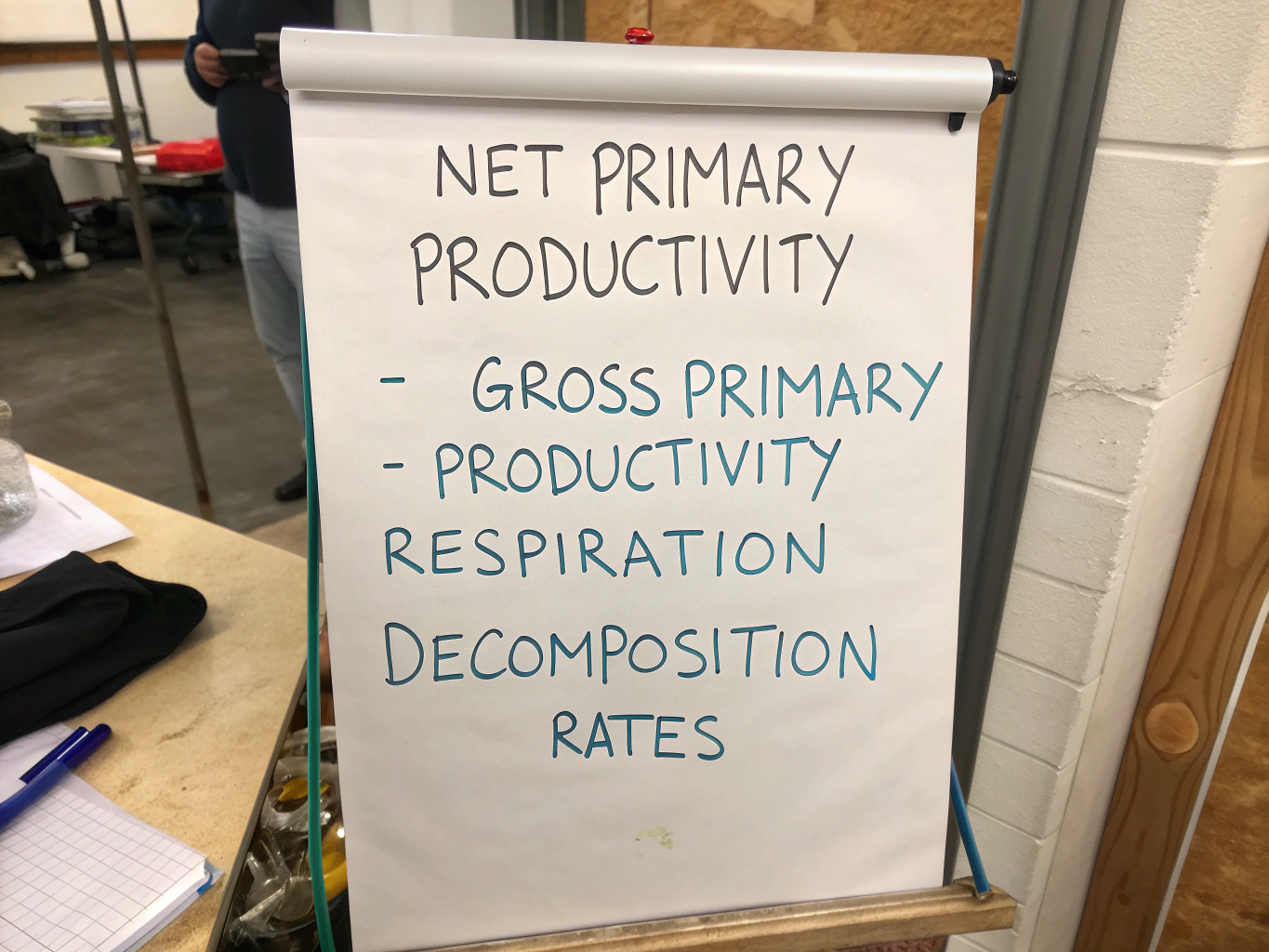How to Easily Understand the Net Primary Productivity Formula
The net primary productivity formula is a fundamental concept that helps us understand how ecosystems function. If you're a student, researcher, or just curious about environmental science in 2025, mastering this concept will give you valuable insights into how our planet's ecosystems work.
What Is Net Primary Productivity?
Net primary productivity (NPP) represents the rate at which all the plants in an ecosystem produce biomass, minus the energy they use for respiration. Think of it as the "profit" of energy that plants store after paying their metabolic "expenses."
This concept is crucial for understanding:
- How ecosystems support life
- Carbon cycling in the environment
- The productivity of different biomes
- Potential agricultural yields
Breaking Down the Net Primary Productivity Formula
The basic net primary productivity formula is surprisingly straightforward:
NPP = GPP – R
Where:
- NPP = Net Primary Productivity
- GPP = Gross Primary Productivity (total energy captured through photosynthesis)
- R = Respiration (energy used by plants for their metabolism)
This simple equation is the foundation of ecosystem productivity measurements worldwide.
Understanding the Components
Gross Primary Productivity (GPP)
Gross Primary Productivity represents the total rate of energy capture through photosynthesis. It's the full amount of carbon that plants convert from atmospheric CO₂ into organic compounds.
Key factors affecting GPP include:
- Sunlight availability
- Temperature
- Water availability
- Nutrient access
- Plant species and density
Respiration (R)
Plants use a portion of the energy they capture for their own metabolic processes. This includes:
- Maintaining existing tissues
- Growing new structures
- Producing flowers and seeds
- Transporting nutrients
- Healing damage

Practical NPP Calculation Guide
Let's explore a practical NPP calculation guide with a simple example:
Measure GPP: Suppose a forest plot produces 1,000 grams of carbon per square meter per year through photosynthesis.
Measure Respiration: The same forest uses 400 grams of carbon per square meter per year for respiration.
Apply the formula: NPP = 1,000 – 400 = 600 grams of carbon per square meter per year.
This value of 600 g C/m²/yr represents the actual carbon stored in new plant tissue that can support the food web.
Why NPP Matters in 2025
As we move through 2025, understanding NPP for students and researchers becomes increasingly important for several reasons:
Climate Change Analysis: NPP helps us understand how ecosystems respond to changing climate conditions.
Food Security: Agricultural systems depend on optimizing NPP to increase yields.
Conservation Planning: Protected area management relies on understanding ecosystem productivity.
Carbon Sequestration: NPP measurements help quantify how effectively different ecosystems capture carbon.
Looking to boost your personal productivity while studying these concepts? Check out our >AI for Productivity eBook + Checklist: Supercharge Your Efficiency in 2236.
Advanced NPP Considerations
When diving deeper into primary productivity explained, several factors complicate the basic formula:
Temporal Variations
NPP isn't constant throughout the year:
- Seasonal changes affect photosynthesis rates
- Growth cycles vary by ecosystem
- Long-term climate patterns impact productivity
Spatial Variations
Different ecosystems have widely varying NPP values:
- Tropical rainforests: 800-1,200 g C/m²/yr
- Temperate forests: 600-800 g C/m²/yr
- Grasslands: 200-400 g C/m²/yr
- Deserts: 0-100 g C/m²/yr
Measurement Methods
Scientists use multiple approaches to understand NPP formula applications in the field:
Harvest Method: Physically collecting and weighing plant material over time.
Gas Exchange: Measuring CO₂ uptake and release.
Remote Sensing: Using satellite data to estimate productivity across large areas.
Models: Applying mathematical relationships between environmental factors and productivity.
For those with ADHD who might find these scientific concepts challenging to focus on, our >ADHD Productivity Power Pack: Ebooks, Guides, Checklists, Workbook & Tools to Master Focus, Time Management & Organization can be tremendously helpful.
Applications in Different Fields
The net primary productivity formula has applications across numerous disciplines:
Ecology
Ecologists use NPP to:
- Compare ecosystem health
- Study energy flow through food webs
- Monitor ecosystem changes over time
- Understand species distributions
Agriculture
Farmers and agricultural scientists apply NPP concepts to:
- Develop more efficient crops
- Optimize growing conditions
- Plan sustainable harvesting
- Predict yields
Environmental Management
Land managers use NPP data to:
- Set sustainable harvest limits
- Identify degraded ecosystems
- Monitor restoration progress
- Develop conservation strategies
Looking for more productivity insights? Check out our guide on best productivity planner PDF options to stay organized.
Common Challenges in NPP Calculation
When applying the NPP calculation guide in real-world situations, several challenges emerge:
Belowground Productivity: Root systems are difficult to measure accurately but can account for 20-80% of total NPP.
Continuous Consumption: Herbivores constantly consume plant matter, complicating biomass measurements.
Environmental Variability: Changing conditions make it difficult to establish baseline measurements.
Scaling Issues: Extrapolating from small sample plots to large ecosystems introduces uncertainties.
For those struggling with productivity while studying these complex concepts, our best apps for ADHD productivity guide offers valuable tools.
Global NPP Patterns
Global ecosystem productivity follows several patterns:
Latitude Gradient: NPP generally decreases as you move from the equator toward the poles due to decreasing temperature and light availability.
Moisture Gradient: Within similar latitude bands, NPP increases with available moisture.
Elevation Gradient: Mountain ecosystems show decreasing NPP with increasing elevation.
Human Impact: Land use changes, pollution, and climate change are altering NPP patterns worldwide.
Future of NPP Research
As we move through 2025 and beyond, NPP for students and researchers will incorporate:
Advanced Remote Sensing: New satellite technologies provide increasingly accurate global NPP estimates.
Artificial Intelligence: Machine learning improves interpretation of complex NPP data.
Integrated Models: Combining climate, biological, and human factors into comprehensive NPP models.
Real-time Monitoring: Networks of sensors providing continuous productivity data.
If you're interested in productivity methods to help with your study of ecological concepts, our article on efficiency vs productivity differences can provide valuable insights.
FAQs About Net Primary Productivity
What is the difference between gross and net primary productivity?
Gross primary productivity (GPP) is the total rate of organic matter production through photosynthesis. Net primary productivity (NPP) is what remains after subtracting the energy plants use for their own respiration. NPP represents the actual energy available to consumers in the ecosystem.
How is NPP measured in the field?
NPP can be measured through harvesting techniques (collecting and weighing plant material over time), gas exchange methods (measuring CO₂ uptake), remote sensing technologies, and mathematical models that incorporate environmental factors like temperature, rainfall, and sunlight.
Why are tropical rainforests the most productive ecosystems?
Tropical rainforests have the highest NPP because they experience ideal conditions for photosynthesis year-round: abundant rainfall, consistent warm temperatures, and high solar radiation. Additionally, their complex canopy structure maximizes light capture at multiple levels.
How does climate change affect NPP?
Climate change affects NPP in complex ways. Increased CO₂ can stimulate plant growth (CO₂ fertilization effect), while changes in temperature and precipitation patterns can either increase or decrease productivity depending on the ecosystem. Extreme weather events can also reduce NPP through plant damage or mortality.
Can NPP be negative?
While technically NPP cannot be negative (as it represents production minus respiration), measurements might show negative values during periods of extreme stress when plants are using more stored energy than they're producing. This typically happens during severe drought, extreme temperatures, or disease outbreaks.
How does NPP relate to carbon sequestration?
NPP directly measures the amount of carbon plants remove from the atmosphere and convert to organic matter. Higher NPP generally means greater carbon sequestration potential, making productive ecosystems important carbon sinks that help mitigate climate change.
Conclusion
The net primary productivity formula gives us a powerful lens for understanding how ecosystems function. By mastering this simple equation (NPP = GPP – R), we gain insights into everything from local garden productivity to global carbon cycles.
Whether you're a student in 2025 looking to understand ecological concepts or a researcher trying to address environmental challenges, this fundamental formula provides a solid foundation for exploring the complex and fascinating world of ecosystem productivity.

